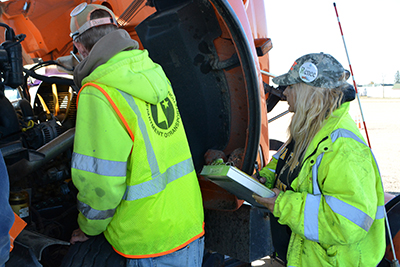 |
|

|
 |
TABLE of CONTENTS
 |
District 4’s addresses section of Hwy 75 prone to spring flooding |
By Jerimiah Moerke, District 4 public affairs coordinator

Crews are currently pouring the piers for the BNSF Railroad bridge. Trains continue to use the tracks, so careful coordination is required with the railroad. Photo by Jerimiah Moerke |
A short section of Hwy 75, which serves as the primary link between Breckenridge and Moorhead, is usually the first road to go under water during flooding events in District 4. A project to address recurring flooding on Hwy 75 near Kent will go through early winter.
The road currently runs under a BNSF Railway bridge and over the nearby Whiskey Creek. The project solves three significant issues with the highway alignment within a one-mile stretch: frequent flooding, a clearance restriction on the BNSF bridge and a structurally deficient bridge with a weight restriction over Whiskey Creek.
A two-year realignment project will fix all three problems. Crews are constructing a new roadway just to the east of the existing roadway. The project includes a new three-span bridge over the railroad tracks and a new bridge over Whiskey Creek.

The current Hwy 75 alignment dates back to the 1930s when drought was the immediate concern. Over the past decade, several major floods have resulted in detours on Hwy 75. The most of significant of them occurred in 2009 when the road was closed for three months due to extended flooding and structural issues with the Whiskey Creek Bridge. Photo courtesy of District 4 |
Fortunately, weather has cooperated almost perfectly, and the project is slightly ahead of schedule. Crews completed most of the new road base. That’s meant adding more than 30 feet of fill to the area near the railroad bridge.
“The challenge has been to build to that height with clay material, while also finding local material of suitable moisture content,” said Dan Kuhn, District 4 bridge/project engineer. “In a short time, we have built the highest point in Wilkin County adjacent to perhaps the lowest points in one of the borrow pits.”
A sub-contractor, Robert R. Schroeder, Inc., will continue building the railroad bridge piers and place beams over the railroad track this fall. At Whiskey Creek, they plan to pour abutments this fall and set beams over the winter while the ground and river are frozen.
In 2016, crews will complete the bridges, pave the new road grade and switch traffic onto the new road. They also need to remove the old pavement, the old bridge over Whiskey Creek, and sections of the road bed. The majority of the material that is removed from the current roadway will be used to fill in the borrow pit where contractors excavated clay for the new roadway. The work is expected to last through the end of the 2016 construction season.
Funding for the $9.8 million dollar project comes from 2008 Chapter 152 bonds ($8.2 million) and trunk highway dollars ($1.5 million).
|
 |
|

|
 |
TABLE of CONTENTS
 |
Instructors share skills, experience during snowplow operators training |
By Rich Kemp

Renee Peterson, SPOT instructor, observes as a student performing a vehicle inspection during the snowplow operator training at Camp Ripley Oct. 22. Photo by Rich Kemp |
When you pull into the gates of Camp Ripley, a National Guard training center near Little Falls, you see a lot more orange this week than camouflage. That’s because MnDOT is conducting snowplow operators training, known as SPOT.
This is the second session of training for employees who will be operating plows during the worst road conditions a typical Minnesota winter has to offer. Fully equipped plows weigh as much as 15 times more than an average car and have to share the roads with those cars while clearing snow from the roadways.
That’s why SPOT training is so important for the operators who plow more than 11,000 miles of state highways and interstates. The instructors play a key role in making sure the MnDOT snowplow operators are trained and ready for the first snowfall.
"Trainers are excited to come to Camp Ripley to share their skills to help shape MnDOT's new snowplow operators,” said Rick Shomion, maintenance training coordinator. “All instructors are trained in adult learning principles and MnDOT safety standards. By combining their work experience and what they learn during train-the-trainer, along with our training curriculum, the trainers are able to work with the trainees in ensuring their success at SPOT."

Students maneuver snowplows through the rodeo course during SPOT training at Camp Ripley Oct. 22. Photo by Rich Kemp |
In the first session, which took place Sept. 21 to Oct. 2, 35 trainers taught 102 trainees. The second session started on Oct. 19 and runs through Oct. 30. During session two, 25 instructors are teaching, observing, giving advice and testing 71 trainees.
The instructors are maintenance supervisors and veteran snowplow operators from around the state.
Renee Peterson, Tracy Truck Station in District 8, has been a SPOT instructor for two years and enjoys working with the students and other instructors.
“I enjoy meeting new people from around the state,” said Peterson. “It is very rewarding to work with the students and see their confidence build.”
The two-week session includes classroom training and hands-on experience that includes safety measures, plowing techniques, updates on new technology and best practices.
“The trainers are all great,” said Peterson. “We work well together. I continue to learn new things every time I come back here, even as an instructor.”
After the classroom training, driving through the rodeo course and driving the roads on and around Camp Ripley, the students have to pass three tests to graduate. They have to pass a snowplow road test, a vehicle inspection test and a written motor carrier safety exam.
When the current session ends Oct. 30, MnDOT will have trained more than 1,400 snowplow operators since SPOT started in 2004. |
 |
|

|
 |
TABLE of CONTENTS
 |
Metro maintenance crews find efficiencies in moving schedule for vehicle inspections |

Metro District maintenance crews met at the Maple Grove truck station in mid-October for a pizza party to celebrate the completion of their Other WIG Supporting Activity—completing the annual commercial vehicle inspections of its fleet of 237 trucks during the summer. Photo by Mike Leegard |
|
With snowflakes hovering on the horizon, Metro District maintenance crews are more than ready to tackle whatever winter delivers, thanks in large part to the work mechanics did this summer overhauling the district’s fleet of trucks.
Normally, the annual commercial vehicle inspections of the district’s 237 trucks are spread throughout the year. By moving the inspection of 72 trucks up from winter to summer, Metro District will now have all 237 of its plows at the ready when the Twin Cities area experiences its first snowfall this season, according to Mike Leegard, acting Metro District maintenance director. Crews will complete outfitting the trucks for winter by Friday, Oct. 30.
As Leegard put it: “Bring on another Halloween blizzard. We’re ready.”
The effort, which occurred from the end of May to the end of October, was one of the district’s supporting activities for MnDOT’s Wildly Important Goal of Enhancing Financial Effectiveness.
“The lead measure for the truck WIG was to get every plow we own in front of a mechanic this summer,” said Leegard, noting that completing all of the inspections in the summer also frees up 72 stalls during the winter so other mechanical repairs can be done.
“It opens the way to other efficiencies,” he said.
Metro District has about 50 mechanics on board, but Leegard said this initiative required everyone in Metro maintenance to roll up their sleeves and contribute to this “big, unified effort.”
“It took a lot of cooperation and sharing of vehicles to keep our summer work going,” he said. “It was a huge effort.” |
|

|
 |
TABLE of CONTENTS
 |
Bob Prudhomme’s death mourned by Statewide Radio Communications office |
|
By Mary McFarland Brooks

Bob Prudhomme, statewide maintenance and operations manager in the Office of Statewide Radio Communications and a member of the Twin Cities Bicycling Club, died Oct. 9 after a bicycling crash. Photo by Robyn Prudhomme |
Bob Prudhomme, statewide maintenance and operations manager in the Office of Statewide Radio Communications, died Oct. 9, one week after a bicycling crash that caused major head trauma. Prudhomme worked for MnDOT’s Metro District for 37 years.
Prudhomme started as a technician in 1979 and then moved to computer operations in the early 1980s before his involvement in the agency’s statewide radio shops in various capacities. He was promoted to statewide maintenance and operations manager in 2005.
Prudhomme was enjoying an after-work bike ride Oct. 2 when the crash occurred. He was operated on at Regions Hospital in St. Paul and was in intensive care for five days prior to his death. An investigation of the incident by the Ramsey County Sheriff’s Office is ongoing.
“Bob was not only a leader among our staff but was a wonderful friend and coworker,” said Tim Lee, assistant director of Statewide Radio Communications, who worked with Prudhomme for 21 years.
“Bob’s work ethic was amazing; he was a team player, smart, funny and somewhat of a prankster,” said Mukhtar Thakur, Statewide Radio Communications director. “After 37 years with MnDOT, Bob was a vast source of knowledge, resources and contacts. He also moved with the times to integrate digital radio and keep up with advancements. Truly, the office lost one of our best.”
Prudhomme’s coworkers at the radio operations center, Trevor Borseth, Tom Bredemus, Steve Bredemus, Brad Hibben, Tom Kaisler, Bruce Williams and Lee Wilson, wrote a tribute to Prudhomme. They described him as a “considerate, constructive, fair and patient mentor in the workplace. Bob’s impressive memory and knowledge of the ARMER system was legendary; he shared it with us daily and helped us all improve.”
Prudhomme is survived by his wife, Robyn; four sons, eight grandchildren and two dogs.
He was a member of the Twin Cities Bicycling Club. Memorials can be directed to the family to be used towards the purchase of bicycles and helmets for Toys for Tots. |
 |
|

|
 |
TABLE of CONTENTS
 |
Cyber security is important at work and home |
By Rich Kemp

This poster was one of the winners in the Minnesota Kids Safe Online Poster Contest, sponsored by MN.IT Services. The contest allows kids to creatively share their knowledge about Internet safety. Photo courtesy of MN.IT Services |
People’s lives are becoming increasingly dependent on technology and cyberspace, from checking email and social networks to searching for information and delivering government services. Criminals and terrorists are finding new ways to leverage this technology to steal information or disrupt daily lives, so it is important MnDOT employees know how to stay safe online. This is important at work and at home.
To bring attention to cyber security, Gov. Mark Dayton proclaimed October as “Cyber Security Awareness Month.”
“I’m glad that in October we focus on Cyber Security, but for many of us it’s a 24/7 job," said Bill Leifheit, chief architect/chief information security officer for MN.IT Services @ DOT. "Our technical staff supports many systems to help protect MnDOT employees online, but everyone has a role in information security: your sharp eyes and good judgment are the best tools to protect agency systems and data.”
At work, it’s important that employees not click on email attachments they weren’t expecting, and to make sure they follow the policies and standards that guide the security of the state systems employees use. Policies and standards can be viewed on the Policy and Standard Library.
At home, it’s important to keep computers and mobile device systems updated and protected to avoid having personal information stolen. Resources on how to do this are on the MN.IT Services website.
The next few issues of Newsline will have cyber security tips to help employees stay safe online. |
 |
|

|
|

|
 |
TABLE of CONTENTS
 |
As Halloween approaches, thousands of bats living beneath I-90 Dresbach Bridge are getting new homes |
By Mike Dougherty, District 6 public affairs coordinator

Bunkers were built near the I-90 Dresbach Bridge as new homes for a bat colony that is making its home under the bridge. Photo by Mike Dougherty |
The Minnesota and Wisconsin departments of transportation in conjunction with environmental agencies recently had new bat homes installed to preserve a little brown bat colony on the north side of the new Interstate 90 bridge abutment at the Dresbach Bridge project.
The aim is to preserve the colony by providing an option that replaces the bats’ living areas once the existing bridge and roosting habitat is removed. The new home is a 4-foot-by-4-foot wooden structure mounted on posts 10 feet to 15 feet tall. An additional six bat bunkers were installed in the area as well.
It is estimated that a colony of 3,000 little brown bats makes its home between the Wisconsin abutment and the first set of bridge piers of the existing I-90 bridge. The Wisconsin DNR believes it’s the largest bat colony in the state. Its presence was discovered by MnDOT bridge inspectors.
This new roosting area is north of the construction limits in the Mississippi River backwaters area near the bats’ old roosting grounds.
Wisconsin DNR conservation biologist Heather Kaarakka said the installation of the alternative habitats was designed so the new structures are in place for when the bats return in the spring. They are hibernating at this point in the season.
"Hopefully, once they remove that bridge, they'll remove the roosting opportunity for them and they'll have discovered and start using the new bat houses," Kaarakka said.
The existing bridge is scheduled to be removed in 2016.
The $187.5 million river bridge project is a cooperative effort between the Minnesota and Wisconsin departments of transportation and will continue through 2016. The project includes constructing a new I-90 crossing over the Mississippi River and reconstructing Hwy 61/Hwy14 and the I-90 interchange.
MnDOT project engineer Mark Anderson said the alternative habitats are a small piece of the project, but reflect how MnDOT reviews its impact on the natural area and how it works to minimize its impact.
Because the deadly bat disease White-Nose Syndrome has been found in Wisconsin, the Wisconsin Department of Natural Resources has been making an effort to preserve existing colonies such as the I-90 bridge colony. MnDOT, WisDOT and the project contractor Ames Construction have worked with the Wisconsin DNR since the start of the project to ensure the new homes and bunkers are in compliance with the Wisconsin DNR’s optimal bat habitat factors.
Bats eat as many as 1,000 mosquito-sized insects per hour, which makes them a critical part of forest and agricultural ecosystems.
Inside the bat condo — a four-foot-square wood structure on stilts — are narrow wood baffles that should provide roost for up to 4,000 bats, which can enter through main doors or squeeze under the eaves. Smaller bunkers should house another 1,500.
Kaarakka said it could take several years to the structures to reach full occupancy, and there’s no guarantee the bats won’t try to occupy the new bridges. |
 |
|
| |
|



